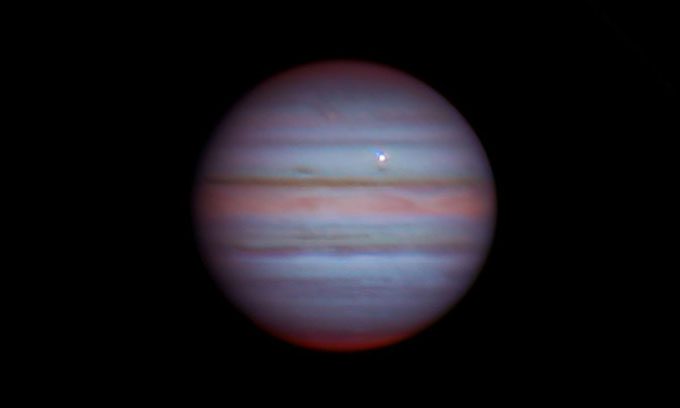A New Study Reveals a Meteorite Weighing Approximately 4.1 Million kg with a Diameter of 15 – 30 m Struck Jupiter Last Year.
In October 2021, astronomers observed a bright flash on Jupiter, the largest planet in the Solar System. A new study published in the Astrophysical Journal Letters indicates that a meteorite collided with the planet, releasing energy equivalent to 2 million tons of explosives, comparable to the Tunguska event that shook Siberia in 1908. This was the most significant impact Jupiter has experienced since 1994, when Comet Shoemaker-Levy 9 collided with it, as reported by IFL Science on June 17.

The flash from the impact on Jupiter in October last year. (Photo: Ko Arimatsu/Kyoto University/PONCOTS)
The meteorite impact occurred on October 15, 2021, and was observed by the PONCOTS system operated by Kyoto University. This marks the first time a dedicated observatory has captured such images. Previously, impacts were mostly discovered by amateur astronomers by chance, making the new images a significant source of scientific data.
For instance, the research team estimates that the meteorite weighed about 4.1 million kg, equivalent to several high-speed space shuttles entering Jupiter’s harsh atmosphere. Based on its mass estimate, the meteorite could be approximately 15 – 30 m wide. While not large, it was traveling fast enough to heat up to 8,000 degrees Celsius.
This is particularly interesting as it provides information that helps scientists determine the type of meteorite involved. Collecting data on impacts far from Earth can aid humanity in preparing for the possibility of a comet or asteroid striking our planet.
The newly captured images appear to be ten times brighter than previous amateur images of impacts. They also help researchers estimate the frequency of such impacts on Jupiter. As a result, impacts occur much more frequently than on Earth, approximately 100 to 1,000 times more often.
The research team plans to launch a long-term monitoring campaign of Jupiter using an upgraded version of the PONCOTS system. “Since the original PONCOTS system was a prototype, it did not support the remote observation mode necessary for long-term monitoring. The new version of the PONCOTS system will support this mode and will be capable of detecting other flashes caused by impacts,” said Dr. Ko Arimatsu, the lead author of the study.


















































